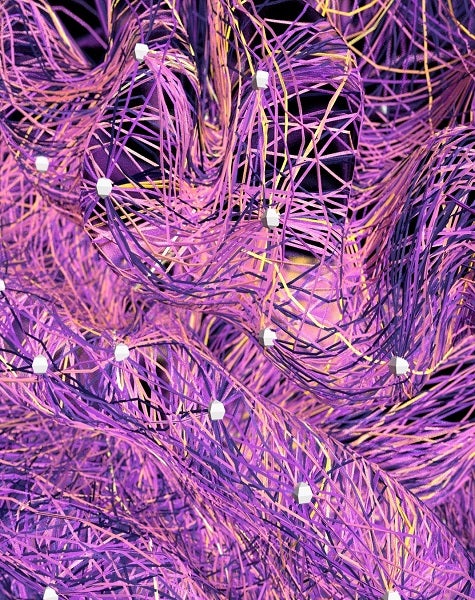By Jiarui Wang and Gabriel Kreiman
Network models seek to explain how individual brain regions critical for vision, hearing, language and other functions, may be integrated to produce the full variety of human behavior. Our latest work, published in Cell Reports, provides the first extensive mesoscopic scale quantitative characterization of functional interactions between areas of human cerebral cortex. This functional connectome will help scientists better understand information flow in the brain, in the future leading to new cures for neurological disorders and the translation of natural intelligence to artificial intelligence algorithms.

The human brain is pictured with its mesoscopic interactome. Coherence measurements from 6,024 hours of human electrophysiological data in 48 subjects were used to build the mesoscopic interactome and demonstrate rapid communication via small-world networks (Wang et al. 2021, Cell Reports).
Collection of neurophysiological activity from the human brain is possible by recruiting subjects undergoing neurosurgery to detect epileptogenic areas. Together with colleagues we curated the largest dataset of continuous intracranial neurophysiological signals, consisting of more than 6,000 hours of activity from 4,124 electrodes spanning the human cerebral cortex. Capitalizing on GPU computing hardware and custom algorithms, we evaluated pairwise interactions across brain regions. Those interactions were validated by comparing with anatomical measurements and previous studies of interactions between pairs of brain areas in monkeys and humans. The human brain functional connectome shows widespread interactions that are spatially specific and change dynamically with cognitive demands.
Interestingly, the human brain functional connectome can be described by a “small world network”. In the same way that people describe six degrees of separation between different individuals, our results show that it is possible to rapidly convey information from any area in the brain to any other area. Such efficient and rapid communication is presumed to be critical for cognitive computations. To assist the exploration of the human brain interactome, we created an interactive web interface tool that allows users to examine the mesoscopic interaction network in 3-D space, where every node and edge can be scrutinized in detail (www.braininteractome.com).
This work is supported by the Center for Brains, Minds and Machines, funded by NSF Science and Technology Center Award CCF-1231216
Jiarui (Jerry) Wang recently obtained his Ph.D. in the lab of Gabriel Kreiman at Boston Children’s Hospital and Harvard Medical School.
Gabriel Kreiman is a Professor of Ophthalmology at Boston Children’s Hospital and Harvard Medical School.
Learn more in the original research article:
Mesoscopic physiological interactions in the human brain reveal small-world properties. Wang J, Tao A, Anderson WS, Madsen JR, Kreiman G. Cell Rep. 2021 Aug 24;36(8):109585. doi: 10.1016/j.celrep.2021.109585. PMID: 34433053; PMCID: PMC8457376.
News Types: Community Stories
